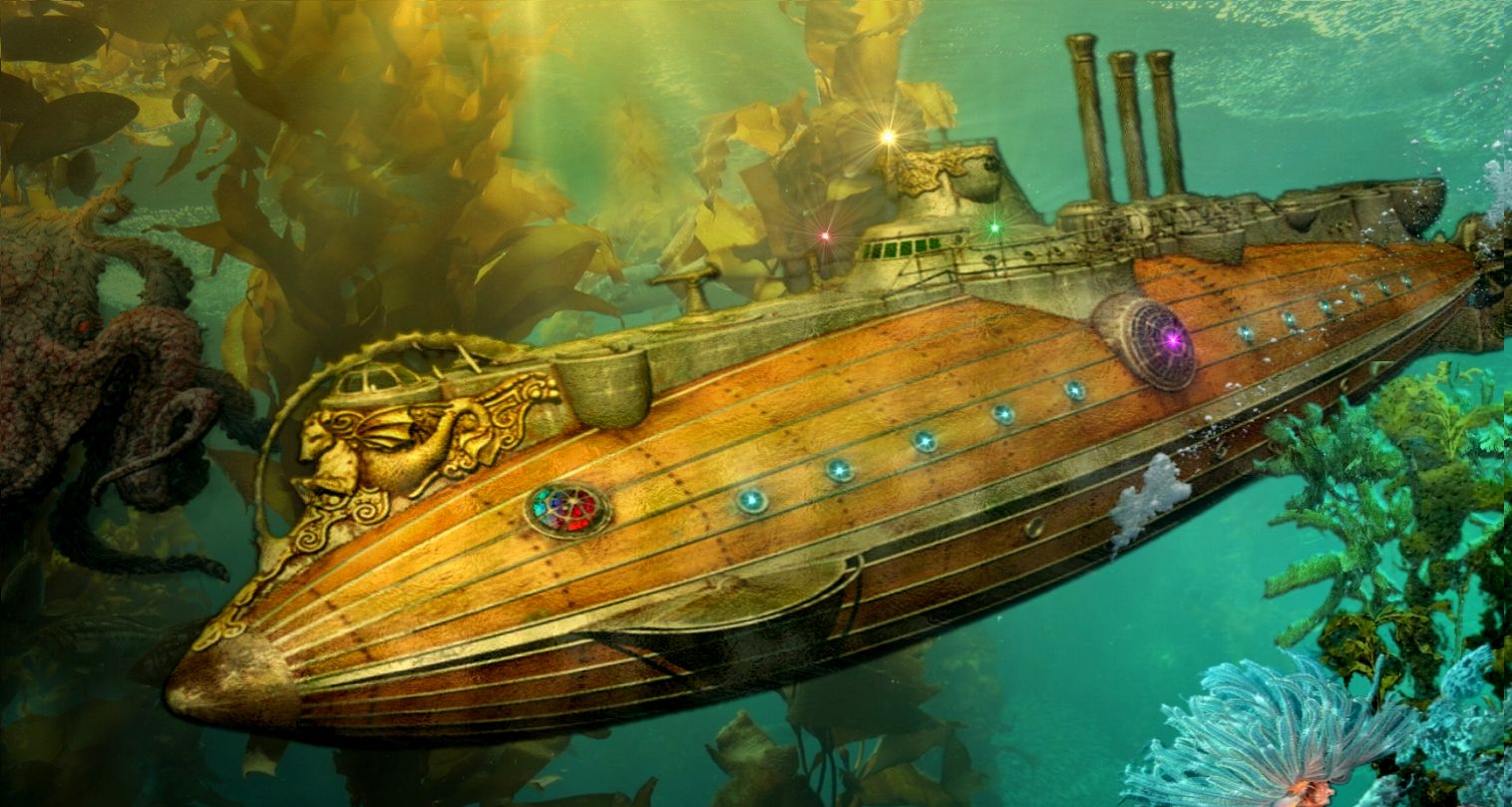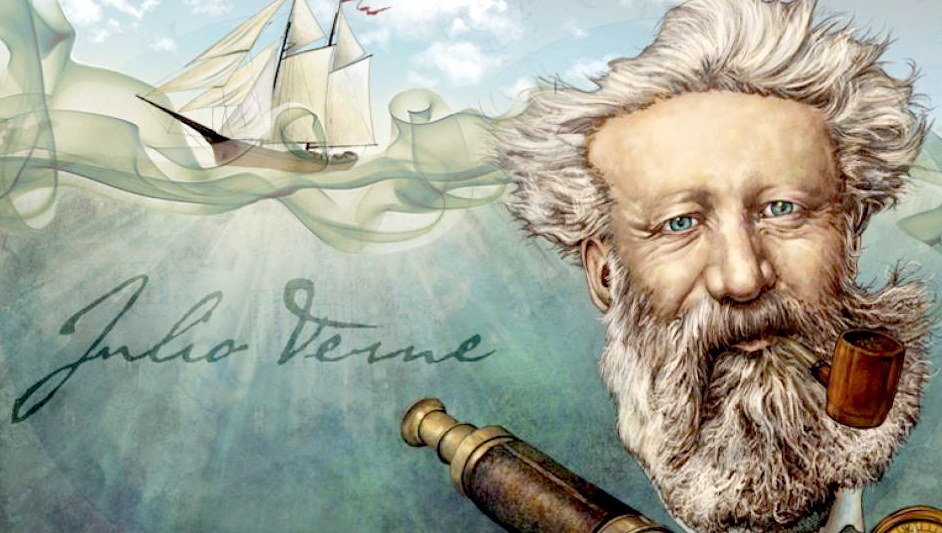|

Best
known for '20,000
Leagues Under the Sea' and Around
The World In Eighty Days, Jules Verne also authored a number of
other popular novels, that made it onto the big screen, such as 'The
Mysterious Island,' and 'Journey To The Centre Of The World.'
'Off On A
Comet' was first published in France (Hetzel Edition, 1877).
The English translation by Ellen E. Frewer, was published in England by Sampson Low (November 1877), and the U.S. by Scribner Armstrong with the title Hector Servadac; Or the Career of a Comet. The Frewer translation alters the text considerably with additions and emendations, paraphrases dialogue, and rearranges material, although the general thread of the story is followed. The translation was made from the serial version of the novel, published January to December 1877.
Verne had problems with this novel from the very beginning. Originally he intended that Gallia would crash into the earth, killing everybody aboard. This may have been the motivation for naming the hero "Servadac" with the mirror of the French word cadavres ("corpses"), predicting all would die on the "return". His publisher Hetzel would not accept this however, given the large juvenile readership in his monthly magazine, and Verne was forced to graft an optimistic ending onto the story, allowing the inhabitants of Gallia to escape the crash in a balloon.
At the same time George Munro in New York published an anonymous translation in a newspaper format as #43 of his Seaside Library books. This is the only literal translation containing all the dialogue and scientific discussions. Unfortunately the translation stops after Part II Chapter 10, and continues with the Frewer translation.
The same year a still different translation by Edward Roth was published in Philadelphia by Claxton, Remsen, and Heffelfinger in two parts. Part I (October 1877) was entitled To the Sun and Part II (May 1878) Off on a Comet. This was reprinted in 1895 by David McKay.
PLOT
The story starts with a comet called Gallia, that touches the Earth in its flight and collects a few small chunks of it. The disaster occurs on January 1 of the year 188x in the area around Gibraltar. On the territory that is carried away by the comet there remain a total of thirty-six people of French, English, Spanish and Russian nationality. These people do not realize at first what has happened, and consider the collision an earthquake.
They first notice weight loss: Captain Servadac's adjutant Ben Zoof, to his amazement, jumps twelve meters high. Zoof with Servadac also soon notice that the alternation of day and night is shortened to six hours, that east and west have changed sides, and that water begins to boil at 66 degrees Celsius, from which they rightly deduce that the atmosphere became thinner and pressure dropped. At the beginning of their stay in Gallia they notice the Earth with the Moon, but think it is an unknown planet. Other important information is obtained through their research expedition with a ship, which the comet also took.
During the voyage they discover a mountain chain blocking the sea, which they initially consider to be the Mediterranean Sea and then they find the island of Formentera (before the catastrophe a part of the Balearic Islands), where they find French astronomer Palmyrin Rosette, who helps them to solve all the mysterious phenomena. They are all on a comet which Rosette discovered by a year ago and predicted to be on a collision course with Earth, but no one believed the astronomer, because a layer of thick fog at the time prevented astronomical observations in other places.
A new research expedition determines the circumference of Gallia to be 2320 km. The mass of the comet is calculated by Rosette. He determines it at 209,346 billion tonnes. For the calculation he uses spring scales and forty 5-franc silver coins, the weight of which on earth equaled exactly one kilogram. However, the owner of the scales, Isaac Hakkabut, has rigged the instrument, so the results have to be cut by a quarter.
The involuntary travelers through the Solar system do not have any hope for long-term colonization of their new world, because it is lacking arable land. They feed themselves mainly with the animals that were left on the chunk carried away by Gallia. One strange phenomenon they meet is that the sea on the comet does not freeze, even though the temperature drops below the freezing point (believed to be due to the theory that a stagnant water surface resists freezing longer than when rippled by wind). Once a stone is thrown into the sea, the sea freezes in a few moments. The ice is completely smooth and allows skating and sleigh sailing.
Despite the dire situation in which the castaways find themselves, old power disputes from Earth continue on Gallia, because the French and English officers consider themselves the representatives of their respective governments. The object of their interest is for example previously Spanish Ceuta, which has become an island on the comet and which both parties start to consider an unclaimed territory. Captain Servadac therefore attempts to occupy Ceuta, without success. It turns out that the island has been occupied by Englishmen, who maintain a connection to their base at Gibraltar through an optical telegraph.
Gallia gets to an extreme point of its orbit and begins its return to Earth. In early November Rossete's refined calculations show that there will be a new collision with the Earth, exactly two years after the first, again on January 1. Therefore, the idea is conceived of leaving the comet at collision time in a balloon. The proposal is approved and the castaways make a balloon out of the sails of their ship. In mid-December there is an earthquake, in which Gallia partially falls apart and loses a fragment, which probably kills all Englishmen in Ceuta and Gibraltar. When on January 1 there is again a contact between the atmospheres of Gallia and Earth, the space castaways leave in the balloon and land safely two kilometers from Mostaganem in Algeria.

..
Jules
Verne was the author of many adventure stories:
1
Twenty Thousand Leagues Under the Sea
- Full
text Part 1, Part
2
2 Around the World in Eighty Days
- Full
text Index
3 Journey to the Center of the Earth
- Full text
Index
4 The Mysterious Island (Extraordinary Voyages #12)
Full
text Part 1, Part
2, Part
3
5 From the Earth to the Moon
6 Michael Strogoff (Extraordinary Voyages, #14)
7 In Search of the
Castaways; or the Children of Captain Grant (Extraordinary Voyages, #5)
8 Five Weeks in a Balloon
9
Round the Moon (Extraordinary Voyages, #7)
10 Adrift in the
Pacific: Two Years Holiday (Extraordinary Voyages, #32)
11 The Master of the World (Extraordinary Voyages, #53)
12 The Adventures of Captain Hatteras
13 Les Tribulations d'un Chinois en Chine;
The Tribulations of a Chinese in China (Extraordinary Voyages, #19)
14 The Lighthouse at the End of the World
15 Mathias Sandorf (Extraordinary Voyages, #27)
16 Off On A Comet (Extraordinary Voyages, #15)
17 Los quinientos millones de la Begún (The five hundred million of the
Begún)
18 Facing the Flag (Extraordinary Voyages, #42)
19 Un capitán de quince años (A fifteen year old captain)
20 El Testamento de un excentrico (The Testament of an eccentric)

Jules
Verne is also known as the Father of Science Fiction
|


